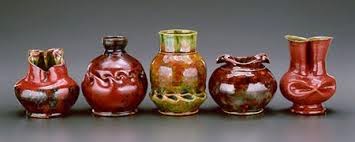George E. Ohr
George E.
Ohr (1857-1918) has been called the first art potter in the United States, and
many say the finest. Ohr was born in Biloxi, Mississippi, July 12 1857. His
father, who he was named after, was a blacksmith. After learning the blacksmith
trade from his father, George Ohr at fourteen left for New Orleans, where he
tried nineteen different jobs. When he was twenty-two he was offered a job as
an apprentice potter in New Orleans. Ohr loved it the moment he began.
After he
had learned his craft, he left New Orleans for a two-year, sixteen-state tour
of potteries in the United States to learn all he could about the profession.
He returned to Biloxi and built his pottery shop himself. Ohr used clay he dug
from around the river where he lived. “Biloxi Art and Novelty Pottery,” as he
called his shop, in no time was crammed with vessels & pots of all shapes,
sizes, and decorations. Ohr presented himself as a wildly eccentric person —
brash, mischievous, wearing flowing beard and hair, and hooking his moustache
over his ears. He gave his business a carnival atmosphere. He called
himself “the mad potter of Biloxi,” because of his wild personality &
equally wild pottery. His shop became a tourist attraction where people could
be entertained as they watched him work.
His extraordinary skill brought him to the attention of the art world. Ohr created extremely delicate, thin-walled pots which he made by twisting, denting, pinching, ruffling, and folding the clay. Unfortunately Ohr's serious creations did not find popularity with the public. Ohr’s energetic and expressionistic treatment of clay was too wild for refined tastes. However, he was called “one of the most interesting potters in the United States,” and one famous ceramics teacher in New York even cited Ohr as a genius. No one would pay the prices he demanded and his refusal to sell his fine pieces at reasonable prices stopped him from getting wide recognition or success.
Ohr gave up his profession as potter in 1909. The famous ceramic shop landmark became Biloxi's first auto repair shop, run by his sons. Ohr packed up several thousand pots and stored them away. He was confident that the world would someday recognize him as “the greatest art potter on earth.” He died of cancer in Biloxi in 1918.
His extraordinary skill brought him to the attention of the art world. Ohr created extremely delicate, thin-walled pots which he made by twisting, denting, pinching, ruffling, and folding the clay. Unfortunately Ohr's serious creations did not find popularity with the public. Ohr’s energetic and expressionistic treatment of clay was too wild for refined tastes. However, he was called “one of the most interesting potters in the United States,” and one famous ceramics teacher in New York even cited Ohr as a genius. No one would pay the prices he demanded and his refusal to sell his fine pieces at reasonable prices stopped him from getting wide recognition or success.
Ohr gave up his profession as potter in 1909. The famous ceramic shop landmark became Biloxi's first auto repair shop, run by his sons. Ohr packed up several thousand pots and stored them away. He was confident that the world would someday recognize him as “the greatest art potter on earth.” He died of cancer in Biloxi in 1918.
Fifty years
after his death, in 1968, an antiques dealer from New Jersey looking for old
cars, happened upon the crates of pots stored in the Ohr Boys' Auto Repair
Shop. He bought all 6,000 pieces for $50,000. As the pots came on the market,
art pottery collectors were intrigued and his pots began to sell for thousands
of dollars each. Today Ohr is well known in the art world for his artistic
pottery creations.
Artwork:
Notice the colors, pinching, folding,
twisting etc on the pots
Project:
What you need:
·
1 baggie of big clay color & 1 baggie small clay colors for each
student
·
1 paper plate for each student
·
1 plastic knife & fork per 2 students
1- Pass out
supplies for each student
2- Instruct
students how to make a “pinch pot” with their large ball of clay.
3- Instruct
students on how to attach clay pieces with cross-hatch marks using a fork. Give
them ideas of what they can add with the other colors of clay ( ie: tongue,
teeth, eyes, ears, feet, hair, antennae).
4- Students need
to write their name on their paper plate and then begin on their creation.









No comments:
Post a Comment